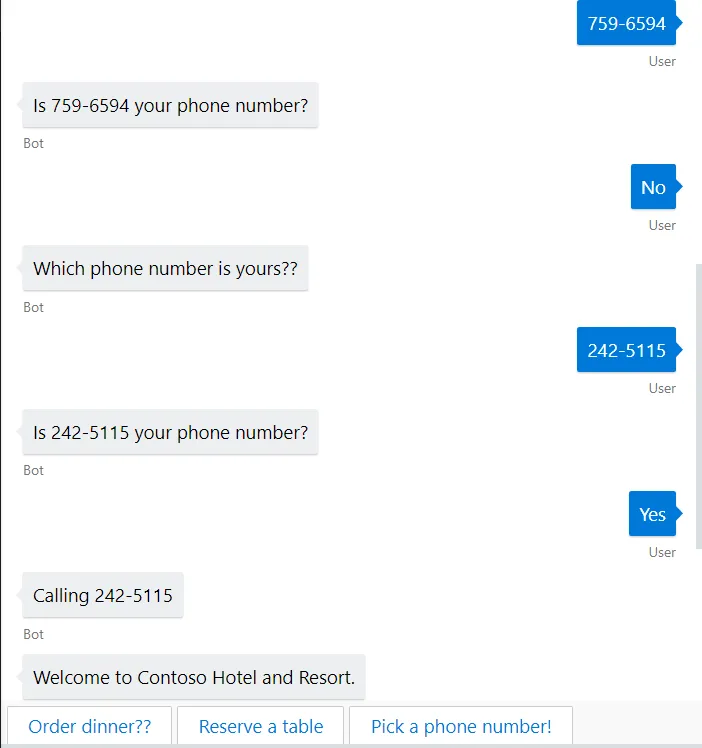我正在尝试创建一个对话框,其中包含多个瀑布步骤。在这个对话框的上下文中,根据用户的选择,有时需要返回到先前的瀑布步骤。我找到了这种方法:
await stepContext.ReplaceDialogAsync("Name of the dialog");
然而,这种方法会重新执行整个对话,这不是我所需要的。
事实上,我创建的瀑布步骤有三步:
- ChoiceCallStepAsync: 第一步将列出用户的前10个通话,并提供选项以显示较旧的通话记录
- ShowCallStepAsync: 第二步将显示用户选择的通话记录,或如果用户点击“显示更旧”则返回第一步
- EndDialog: 第三步将终止对话
我的代码如下:
public class ListAllCallsDialog : ComponentDialog
{
// Dialog IDs
private const string ProfileDialog = "ListAllCallsDialog";
/// <summary>
/// Initializes a new instance of the <see cref="ListAllCallsDialog"/> class.
/// </summary>
/// <param name="loggerFactory">The <see cref="ILoggerFactory"/> that enables logging and tracing.</param>
public ListAllCallsDialog(ILoggerFactory loggerFactory)
: base(nameof(ListAllCallsDialog))
{
// Add control flow dialogs
var waterfallSteps = new WaterfallStep[]
{
ListAllCallsDialogSteps.ChoiceCallStepAsync,
ListAllCallsDialogSteps.ShowCallStepAsync,
ListAllCallsDialogSteps.EndDialog,
};
AddDialog(new WaterfallDialog(ProfileDialog, waterfallSteps));
AddDialog(new ChoicePrompt("cardPrompt"));
}
/// <summary>
/// Contains the waterfall dialog steps for the main dialog.
/// </summary>
private static class ListAllCallsDialogSteps
{
static int callListDepth = 0;
static List<string> Calls;
public static async Task<DialogTurnResult> ChoiceCallStepAsync(WaterfallStepContext stepContext, CancellationToken cancellationToken)
{
await stepContext.Context.SendActivityAsync(
"Right now i'm in list all calls dialog",
cancellationToken: cancellationToken);
GetAllCalls();
return await stepContext.PromptAsync("cardPrompt", GenerateOptions(stepContext.Context.Activity, callListDepth), cancellationToken);
}
public static async Task<DialogTurnResult> ShowCallStepAsync(WaterfallStepContext stepContext, CancellationToken cancellationToken)
{
// Get the text from the activity to use to show the correct card
var text = stepContext.Context.Activity.Text.ToLowerInvariant();
if(text == "Show older")
//Go back to the first step
else if(text == "Show earlier")
//Go back to the first step
else
await stepContext.Context.SendActivityAsync(
"The call you choose is : " + text.ToString(),
cancellationToken: cancellationToken);
return await stepContext.ContinueDialogAsync();
}
public static async Task<DialogTurnResult> EndDialog(WaterfallStepContext stepContext, CancellationToken cancellationToken)
{
await stepContext.Context.SendActivityAsync(
"Getting back to the parent Dialog",
cancellationToken: cancellationToken);
return await stepContext.EndDialogAsync(null, cancellationToken);
}
/// <summary>
/// Creates options for a <see cref="ChoicePrompt"/> so the user may select an option.
/// </summary>
/// <param name="activity">The message activity the bot received.</param>
/// <returns>A <see cref="PromptOptions"/> to be used in a prompt.</returns>
/// <remarks>Related type <see cref="Choice"/>.</remarks>
private static PromptOptions GenerateOptions(Activity activity, int callListDepth)
{
// Create options for the prompt
var options = new PromptOptions()
{
Prompt = activity.CreateReply("Please choose a call from the list below"),
Choices = new List<Choice>(),
};
for(int i=10*callListDepth; i <= 10 * (callListDepth + 1); i++)
{
if (Calls.ElementAtOrDefault(i) != null)
options.Choices.Add(new Choice() { Value = Calls[i] });
}
options.Choices.Add(new Choice() { Value = "Show older" });
if(callListDepth!=0)
options.Choices.Add(new Choice() { Value = "Show earlier" });
return options;
}
private static void GetAllCalls()
{
//List of all calls found
for (int i = 0; i < 30; i++)
Calls.Add("Call" + i.ToString());
}
}
有人可以给我演示一下如何做吗?
